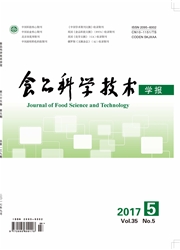

 中文摘要:
中文摘要:
以福建产鲜活杂色蛤(Ruditapes philippinarum)、缢蛏(Sinonovacula constricta)、褶牡蛎(Ostrea plicatula)和皱纹盘鲍(Haliotis discus hannai)为研究对象,每月分别检测其汤汁中的游离氨基酸、核苷酸、糖原含量,以探明这3种主要呈味物质的季节性变化规律。结果显示:4种贝类的呈味氨基酸含量在1—4月份较高,特别是2—3月份的质量含量均在2000 mg/kg以上,而6—8月份间的杂色蛤、皱纹盘鲍、褶牡蛎以及9月份的缢蛏的呈味氨基酸含量相对较低;在呈味核苷酸含量方面,4种贝类在1—4月份含量较高,特别是缢蛏和杂色蛤的含量均大于400μg/g,而7—10月份的含量相对较低;同时,4种贝类的糖原含量也表现出相似的规律,在2—4月份较高,9—10月份则较低。可见,4种海洋贝类在呈味物质的含量上均表现出明显的冬春季节高于夏秋两季的规律。
 英文摘要:
英文摘要:
This study analyzed the seasonal variation in the content of free amino acids,nucleotide,glycogen from the cooking liquor of four species of marine shellfish,including Ruditapes philippinarum,Sinonovacula,Ostrea plicatula,and Haliotis discus hanna. The results showed that the contents of taste-active amino acids in the four species of marine shellfish were relatively high during the period from January to April,especially in February and March,which was more than 2000 mg / kg. While,it was relatively low in Ruditapes philippinarum,Haliotis discus hanna and Ostrea plicatula during the period from June to August,and Sinonovacula in September. The content of taste-active nucleotide was high in all four species of shellfish from January to April,especially Sinonovacula and Ruditapes philippinarum revealed values higher than 400 μg / g while was relatively low between July and October. On the other hand,the content of glycogen showed the similar tendency in four species of shellfish. They were all high from February to April and low in September and October. In conclusion,the contents of taste-active components in the four species of marine shellfish were higher in winter and early spring than those in summer and autumn.
 同期刊论文项目
同期刊论文项目
 同项目期刊论文
同项目期刊论文
 期刊信息
期刊信息
